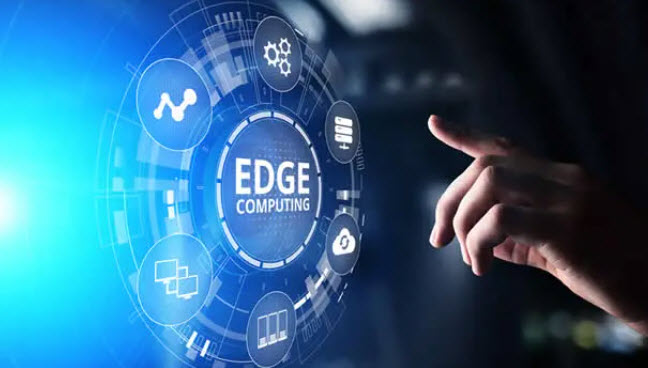What exactly is Edge Computing?
Edge computing is rapidly emerging as a key enabler for a new generation of technologies and services. As computing technologies become ever-smaller, more powerful and cheaper, they are increasingly being deployed to collect and process data on-site rather than simply storing or transmitting it for processing at a central location. We are seeing this occur across cities, in cars, workplaces, homes as well as on wearables. According to IDC, global spending on Edge computing will hit $250 billion by 2024.
So what exactly is Edge computing? Like most emerging areas of technology, definitions of Edge computing vary across vendors, analysts and the media more generally.
This guide outlines some of the key Edge computing definitions from experts and commentators across the technology sector.
Analysts’ Definitions of Edge Computing
Gartner
“Edge computing is part of a distributed computing topology where information processing is located close to the edge, where things and people produce or consume that information.” [1]https://www.gartner.com/en/information-technology/glossary/edge-computing
IDC
“IDC defines the edge as the multiform space between physical endpoints (a sensor, an industrial machine, a vehicle, for example) and the “core” (the backend sitting in cloud locations or traditional datacenters, usually seen as the physical or virtual space in which to compute and store data).” [2]https://blog-idcuk.com/everything-is-edge-and-edge-is-everywhere/
Network Engineers’ definitions of the Edge Computing
IEEE
“Edge computing is a new paradigm in which the resources of an edge server are placed at the edge of the Internet, in close proximity to mobile devices, sensors, end users, and the emerging IoT.” [3]https://ieeexplore.ieee.org/stamp/stamp.jsp?arnumber=8789742
Vendors’ Definitions of Edge Computing
IBM
“Edge computing is a distributed computing framework that brings enterprise applications closer to data sources such as IoT devices or local edge servers.” [4]https://www.ibm.com/uk-en/cloud/what-is-edge-computing
Hewlett Packard Enterprise
“Edge computing is a distributed, open IT architecture that features decentralised processing power, enabling mobile computing and Internet of Things (IoT) technologies. In edge computing, data is processed by the device itself or by a local computer or server, rather than being transmitted to a data centre.” [5]https://www.hpe.com/uk/en/what-is/edge-computing.html
Microsoft
“Edge computing is where compute resources, ranging from credit-card-size computers to micro data centers, are placed closer to information-generation sources, to reduce network latency and bandwidth usage generally associated with cloud computing.” [6]https://www.microsoft.com/en-us/research/project/edge-computing/
Trade Press Definitions of Edge computing
The Verge (Paul Miller)
“Edge computing is computing that’s done at or near the source of the data, instead of relying on the cloud at one of a dozen data centers to do all the work. It doesn’t mean the cloud will disappear. It means the cloud is coming to you.” [7]https://www.theverge.com/circuitbreaker/2018/5/7/17327584/edge-computing-cloud-google-microsoft-apple-amazon
Network World (Keith Shaw)
“Edge computing brings computation and data storage closer to the devices where it’s being gathered, rather than relying on a central location that can be thousands of miles away.” [8]https://www.networkworld.com/article/3224893/what-is-edge-computing-and-how-it-s-changing-the-network.html
Cloudwards (Eric Hamilton)
“Edge computing is: the processing and analyzing of data along a network edge, closest to the point of its collection, so that data becomes actionable.” [9]https://www.cloudwards.net/what-is-edge-computing/
Dictionary/Encyclopedia definitions of Edge Computing
Wikipedia
“Edge computing is a distributed computing paradigm that brings computation and data storage closer to the location where it is needed, to improve response times and save bandwidth.” [10]https://en.wikipedia.org/wiki/Edge_computing
Techopedia
“Edge computing in IT is defined as the deployment of data-handling activities or other network operations away from centralized and always-connected network segments, and toward individual sources of data capture, such as endpoints like laptops, tablets or smartphones.” [11]https://www.techopedia.com/definition/32472/edge-computing
Regulators’ / Policy Makers’ definitions of EDGE Computing
Federal Communications Commission (FCC)
“Edge computing refers to locating applications – and the general-purpose compute, storage, and associated switching and control functions needed to run them – relatively close to end users and/or IoT endpoints.” [12]https://transition.fcc.gov/bureaus/oet/tac/tacdocs/reports/2018/5G-Edge-Computing-Whitepaper-v6-Final.pdf
Bankers’ definitions of Edge Computing
Goldman Sachs
“In edge computing, data is processed, analyzed, and acted upon at (or close to) the source of data generation, as opposed to raw data being sent directly to a public or private cloud to be acted upon.” [13]https://www.gspublishing.com/content/research/en/reports/2019/09/04/148294ef-31fe-4e25-b807-25977de46de4.pdf
References
| ↑1 | https://www.gartner.com/en/information-technology/glossary/edge-computing |
|---|---|
| ↑2 | https://blog-idcuk.com/everything-is-edge-and-edge-is-everywhere/ |
| ↑3 | https://ieeexplore.ieee.org/stamp/stamp.jsp?arnumber=8789742 |
| ↑4 | https://www.ibm.com/uk-en/cloud/what-is-edge-computing |
| ↑5 | https://www.hpe.com/uk/en/what-is/edge-computing.html |
| ↑6 | https://www.microsoft.com/en-us/research/project/edge-computing/ |
| ↑7 | https://www.theverge.com/circuitbreaker/2018/5/7/17327584/edge-computing-cloud-google-microsoft-apple-amazon |
| ↑8 | https://www.networkworld.com/article/3224893/what-is-edge-computing-and-how-it-s-changing-the-network.html |
| ↑9 | https://www.cloudwards.net/what-is-edge-computing/ |
| ↑10 | https://en.wikipedia.org/wiki/Edge_computing |
| ↑11 | https://www.techopedia.com/definition/32472/edge-computing |
| ↑12 | https://transition.fcc.gov/bureaus/oet/tac/tacdocs/reports/2018/5G-Edge-Computing-Whitepaper-v6-Final.pdf |
| ↑13 | https://www.gspublishing.com/content/research/en/reports/2019/09/04/148294ef-31fe-4e25-b807-25977de46de4.pdf |


[…] forget to visit our Edge Computing Definitions page as […]